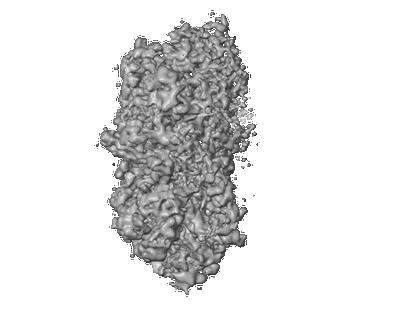EMD-11088
Transcription termination intermediate complex 2
EMD-11088
Single-particle5.7 Å
 Deposition: 28/05/2020
Deposition: 28/05/2020Map released: 13/01/2021
Last modified: 28/07/2021
Sample Organism:
Escherichia coli
Sample: Transcription termination complex
Deposition Authors: Said N, Hilal T, Buerger J, Mielke T, Loll B, Wahl MC
Sample: Transcription termination complex
Deposition Authors: Said N, Hilal T, Buerger J, Mielke T, Loll B, Wahl MC
Steps toward translocation-independent RNA polymerase inactivation by terminator ATPase rho.
Said N  ,
Hilal T
,
Hilal T  ,
Sunday ND
,
Sunday ND  ,
Khatri A,
Burger J
,
Khatri A,
Burger J  ,
Mielke T
,
Mielke T  ,
Belogurov GA
,
Belogurov GA  ,
Loll B
,
Loll B  ,
Sen R
,
Sen R  ,
Artsimovitch I
,
Artsimovitch I  ,
Wahl MC
,
Wahl MC 
(2021) Science , 371
 ,
Hilal T
,
Hilal T  ,
Sunday ND
,
Sunday ND  ,
Khatri A,
Burger J
,
Khatri A,
Burger J  ,
Mielke T
,
Mielke T  ,
Belogurov GA
,
Belogurov GA  ,
Loll B
,
Loll B  ,
Sen R
,
Sen R  ,
Artsimovitch I
,
Artsimovitch I  ,
Wahl MC
,
Wahl MC 
(2021) Science , 371
Abstract:
Factor-dependent transcription termination mechanisms are poorly understood. We determined a series of cryo-electron microscopy structures portraying the hexameric adenosine triphosphatase (ATPase) ρ on a pathway to terminating NusA/NusG-modified elongation complexes. An open ρ ring contacts NusA, NusG, and multiple regions of RNA polymerase, trapping and locally unwinding proximal upstream DNA. NusA wedges into the ρ ring, initially sequestering RNA. Upon deflection of distal upstream DNA over the RNA polymerase zinc-binding domain, NusA rotates underneath one capping ρ subunit, which subsequently captures RNA. After detachment of NusG and clamp opening, RNA polymerase loses its grip on the RNA:DNA hybrid and is inactivated. Our structural and functional analyses suggest that ρ, and other termination factors across life, may use analogous strategies to allosterically trap transcription complexes in a moribund state.
Factor-dependent transcription termination mechanisms are poorly understood. We determined a series of cryo-electron microscopy structures portraying the hexameric adenosine triphosphatase (ATPase) ρ on a pathway to terminating NusA/NusG-modified elongation complexes. An open ρ ring contacts NusA, NusG, and multiple regions of RNA polymerase, trapping and locally unwinding proximal upstream DNA. NusA wedges into the ρ ring, initially sequestering RNA. Upon deflection of distal upstream DNA over the RNA polymerase zinc-binding domain, NusA rotates underneath one capping ρ subunit, which subsequently captures RNA. After detachment of NusG and clamp opening, RNA polymerase loses its grip on the RNA:DNA hybrid and is inactivated. Our structural and functional analyses suggest that ρ, and other termination factors across life, may use analogous strategies to allosterically trap transcription complexes in a moribund state.
